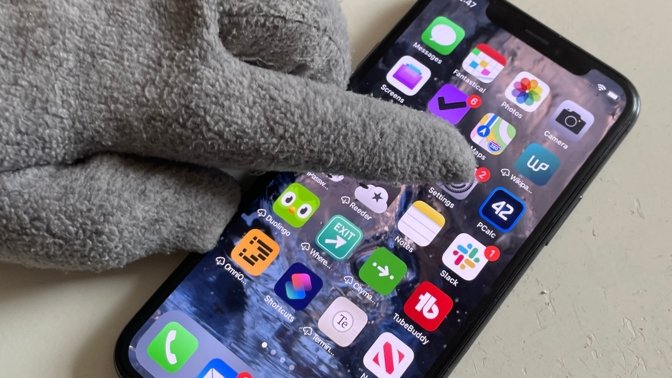If Apple's research on how to have its devices register touch without you even needing to press on the glass, you won't need to take off your gloves off to answer your iPhone in the future.

Use your iPhone and stay stylish -- or just warm -- while you do so
"We're going to use the best pointing device in the world," said Steve Jobs at the iPhone launch. "We're going to use a pointing device that we're all born with, we're born with ten of them, we're going to use our fingers."
That sounded so great -- and it was, certainly when compared to the kind of stylus you had to use with previous smartphones. Yet it required skin contact on the glass, and that's why it didn't work with gloves.
It's also why gloved people sometimes answer calls with their nose, or at least why it works when they do. Now Apple wants to make it so that you can keep your nose clean, and your gloves on, too.
"Glove touch detection," is a newly-revealed patent that is chiefly concerned with how an iPhone, or other device, can use proximity to detect when a user wants to press on a screen.
"Detecting touch can include sensing touch signals of an input patch corresponding to a proximate object (e.g., a conductive object such as a finger or stylus), for example," says the patent.
Normally, an iPhone screen has always worked by detecting a change when you press against the glass. It's very smart at knowing when you intended to do that and when you've just inadvertently picked up the phone at an angle.
And part of that smartness is in making a choice. The iPhone can register a press and know, for instance, how close it is to an icon or button on the screen. It can know how long the user presses, and it can tell the difference between a stabbing finger motion and a grip.
In each case, what this boils down to is that there is a point at which the device figures you meant it. Apple calls this the "touch detection threshold."
"For example, a user may be wearing gloves while operating an electronic device with a touch screen," continues the patent. "The electronic device may not be able to detect a gloved finger touching the touch screen because the touch signal generated in response to the touching gloved finger may not reach the tuned touch detection threshold of the electronic device."
This patent proposes assuming a touch was intended if a change is registered in a certain place on the screen, for a certain time -- and perhaps also not repeated.
"[The] predetermined criteria are satisfied in response to detecting a slope of a signal density that corresponds to a gloved finger touching the panel and lifting off from the panel," says Apple, "without re-approaching the panel within a predetermined period of time."
Detail from the patent showing a finger pressing down on what looks like a Rube Goldberg machine
Most of the 18,000-word patent concentrates on issues of the voltage generated when a user presses on what Apple calls an "input patch," or a touchable area. But the screen -- on an iPhone, iPad, or any other device -- cannot only be used by gloved hands, it has to work with bare fingers too.
"[So] it is advantageous to dynamically change the touch threshold depending on whether the user is interacting with the electronic device while wearing gloves (or having some other barrier, such as a bandages)," says Apple, "or interacting with the electronic device with bare fingers."
Apple proposes that devices can "operate in one of a 'bare finger mode'" by default, and "a 'glove mode'" where it changes the degree of touch pressure it responds to.
This patent is credited to two inventors, Siddharth Dedhia, and Xiaoqi Zhou. The latter has very many previous patents, including a related one concerning the architecture of a touch sensor panel.
As well as researching how screens could respond to gloved touches, Apple has also recently been revealed to be investigating smart gloves. "Apple Glass" owners may also wear magnetic smart gloves that interact with AR and VR experiences, though you can bet they'll have to pay extra for them.
Stay on top of all Apple news right from your HomePod. Say, "Hey, Siri, play AppleInsider," and you'll get latest AppleInsider Podcast. Or ask your HomePod mini for "AppleInsider Daily" instead and you'll hear a fast update direct from our news team. And, if you're interested in Apple-centric home automation, say "Hey, Siri, play HomeKit Insider," and you'll be listening to our newest specialized podcast in moments.


